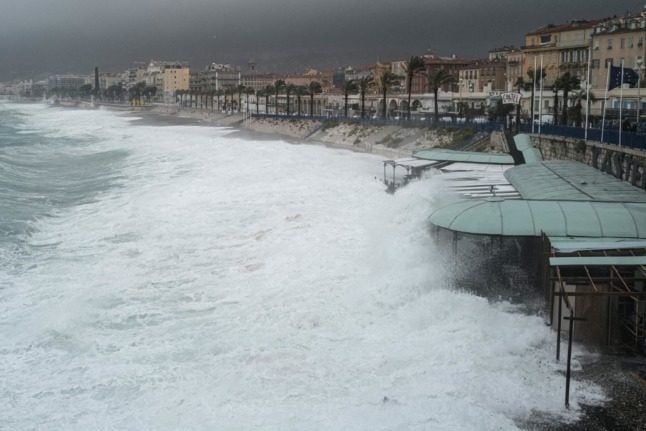- In Images: Torrential flooding in Spain's Navarre leaves one dead and towns under water
- Rafa Nadal donates €1million to help victims of Mallorca floods
- Spain battered by weekend storms and floods and there’s more to come
FLOOD
Spain’s PM visits flood-hit regions as death toll hits six
Spanish Prime Minister Pedro Sanchez on Saturday visited the country's flood-stricken southeastern regions as the death toll rose to six and train and air services were disrupted for a third day.
Published: 14 September 2019 18:00 CEST

A police car is parked on a flooded street on September 14, 2019 in Dolores as torrential rains hit southeastern Spain. Photo: Ramon/AFP
Since Wednesday, areas here suffered some of the heaviest daily rainfall on record, causing chaos on the roads, cutting public transport and prompting rivers to burst their banks.
Flash floods swept away cars and swamped homes in the regions of Valencia, Murcia and eastern Andalusia.
The latest fatality was a middle-aged man whose body was found by police in a field at a hamlet near the city of Orihuela in Valencia, a spokeswoman for the central government's office in the region said, without giving details.
Five people died in separate accidents in the previous two days as they tried to cross flooded roads in cars, including a man whose vehicle got stuck in a tunnel on Friday in the centre of the coastal city of Almeria.
After observing the damage from a helicopter flying over the city of Orihuela in the region of Valencia, Sanchez visited a command centre for emergency operations.
Later he offered his condolences to the families of the dead and said the government would do everything it could to help the survivors.
“All those who have been affected need to know that the Spanish government will help so that at least they can repair many of the material damages caused by this extraordinary meteorological phenomenon,” he told reporters as he
arrived in Murcia.
The prime minister said water levels need to lower before the government can make an estimate of the total cost of the damage.
READ ALSO:
In addition to some 1,500 people who were evacuated earlier, officials on Friday removed another 2,000 residents of the town of Santomera in the region of Murcia as a precaution due to a controlled release from a local dam to avoid overflowing, the interior ministry said.
Spain's King Felipe VI also lamented the loss of life and the damage.
“May we all, with the help of all, be able to overcome the despair that now weighs on so many homes and families,” he tweeted late on Friday.
The storm moved further west on Saturday, causing a flash flood in the village of Alhaurin el Grande in the province of Malaga that washed away about a dozen cars, local officials said.
The southwestern city of Seville closed all public parks on Saturday due to the risk of heavy rainfall, city hall said in a tweet.
The airport in Murcia, which was closed on Friday due to the flooding, re-opened on Saturday. However two flights that were due to land on the holiday island of Ibiza were diverted to another airport and two other flights were cancelled due to the bad weather, Spanish airports operator AENA said.
Rail services across southeastern Spain remained disrupted on Saturday, with several routes in Valencia and Murcia suspended, the state-owned train operator said in a statement.
Url copied to clipboard!


 Please whitelist us to continue reading.
Please whitelist us to continue reading.
Member comments